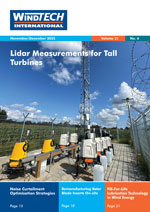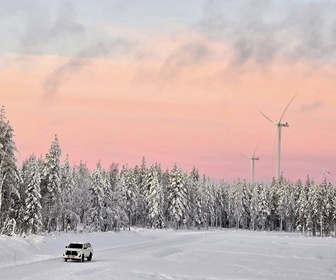- Category: Articles
Valuable Data for the Wind Power Industry
 Research at the National Aeronautics and Space Administration’s (NASA’s) Earth Science Enterprise is complementing the development of offshore wind power in the USA. The American space agency is experimenting with a new technology to measure surface-level sea winds from orbit. Created for monitoring marine weather conditions in general, this technique could evolve into an operational system that would supply valuable data to the wind power industry. Not surprisingly, a high vantage point may offer the best view for offshore wind information.
Research at the National Aeronautics and Space Administration’s (NASA’s) Earth Science Enterprise is complementing the development of offshore wind power in the USA. The American space agency is experimenting with a new technology to measure surface-level sea winds from orbit. Created for monitoring marine weather conditions in general, this technique could evolve into an operational system that would supply valuable data to the wind power industry. Not surprisingly, a high vantage point may offer the best view for offshore wind information.By Avery Sen, Policy Analyst and ORISE Fellow, National Oceanic and Atmospheric Administration
- Category: Articles
Optimising Capacitors for Wind Power Applications
.jpg) All wind turbines face a similar set of challenges. They need to extract power at low wind speeds and fluctuating wind profiles in order to maintain adequate yield. They also need to ensure adequate power quality to operate appliances or to feed into a grid. In addition, the electrical system must be constructed to minimise losses and thereby maintain high efficiency and reliability. In this article, the author, from Vishay Intertechnology, Inc, discusses how capacitors can be optimised to meet these challenges.
All wind turbines face a similar set of challenges. They need to extract power at low wind speeds and fluctuating wind profiles in order to maintain adequate yield. They also need to ensure adequate power quality to operate appliances or to feed into a grid. In addition, the electrical system must be constructed to minimise losses and thereby maintain high efficiency and reliability. In this article, the author, from Vishay Intertechnology, Inc, discusses how capacitors can be optimised to meet these challenges.By Josef Reindl, Vishay ESTA, Theo van de Steeg and Frans van Roemburg, Vishay BCcomponents
- Category: Articles
A Commentary on the Issues Facing Wind Park Developers in the UK
 The UK offshore wind energy sector is booming at the moment. This is largely because of the UK government’s ‘Renewables Obligation’ targets for the generation of electricity from renewable sources of 10% by 2010 and 15% by 2015. As the windiest country in Europe, the UK is in a very good position to fulfil the targets by installing many wind parks in the relatively shallow waters extending into the North Sea. In this article, the author describes the legal implications for offshore wind farms.
The UK offshore wind energy sector is booming at the moment. This is largely because of the UK government’s ‘Renewables Obligation’ targets for the generation of electricity from renewable sources of 10% by 2010 and 15% by 2015. As the windiest country in Europe, the UK is in a very good position to fulfil the targets by installing many wind parks in the relatively shallow waters extending into the North Sea. In this article, the author describes the legal implications for offshore wind farms.
 The UK offshore wind energy sector is booming at the moment. This is largely because of the UK government’s ‘Renewables Obligation’ targets for the generation of electricity from renewable sources of 10% by 2010 and 15% by 2015. As the windiest country in Europe, the UK is in a very good position to fulfil the targets by installing many wind parks in the relatively shallow waters extending into the North Sea. In this article, the author describes the legal implications for offshore wind farms.
The UK offshore wind energy sector is booming at the moment. This is largely because of the UK government’s ‘Renewables Obligation’ targets for the generation of electricity from renewable sources of 10% by 2010 and 15% by 2015. As the windiest country in Europe, the UK is in a very good position to fulfil the targets by installing many wind parks in the relatively shallow waters extending into the North Sea. In this article, the author describes the legal implications for offshore wind farms.By Jonathan Lux, Partner, Ince & Co, UK
- Category: Articles
Case Study and Cost–Benefit Analysis on Implementation of CBM
The focus of this case study and cost–benefit analysis is an application of a condition-based monitoring (CBM) tool installed in a 700kW wind turbine generator at a project based in the USA. The installation was in response to reports that several wind farms had experienced catastrophic gearbox failures, resulting in exorbitant costs and lost revenues. It began in summer 2003 with a cooperative pilot study, the objective being implementation of a ‘trial installation’ that would demonstrate the benefits of a CBM system on a wind turbine to help prevent catastrophic failures.
By Staff Writer, Prasentia, and Roland Kewitsch, Product Manager, Schenck-Trebel, USA
- Category: Articles
Assessing Their Potential Impact on Project Profitability
By Bernard Chabot, Senior Expert, ADEME, France
.
Wind power generates CO2-free electricity and so it can also generate ‘carbon credits’ attached to each delivered kWh. If an environmental derivative market is available, the profitability of a wind power project will result from selling electricity to the energy market and also from selling ‘carbon credits’ on such a derivative market. And this will be more and more possible as the Kyoto Protocol and its attached main ‘flexibility mechanism’ the Clean Development Mechanism (CDM) enter into force in 2005 together with the European Trading System (ETS). This article describes a simple and reliable method to assess the increase in profitability by selling carbon credits.
By Bernard Chabot, Senior Expert, ADEME, France
- Category: Articles
New Market Requirements
Large offshore wind farms are a potential source to supplement the power generation portfolio in Europe. The offshore environment and the high investment demand a professional approach throughout project development, the contracting and the operational phase. The investment for the electrical transmission system amounts to around 25% and is therefore an essential part of the total project. This article addresses the numerous new market requirements on the electrical transmission system for large offshore wind farms caused by the project structure, the electrical system design and the commercial and contractual conditions.
By Juergen Bernauer, Vice-President, ABB Wind Power Integration, GermanyLarge offshore wind farms are a potential source to supplement the power generation portfolio in Europe. The offshore environment and the high investment demand a professional approach throughout project development, the contracting and the operational phase. The investment for the electrical transmission system amounts to around 25% and is therefore an essential part of the total project. This article addresses the numerous new market requirements on the electrical transmission system for large offshore wind farms caused by the project structure, the electrical system design and the commercial and contractual conditions.
- Category: Articles
Condition Monitoring and Predictive Maintenance
 The rapidly growing number of wind turbines, providing an increasingly credible alternative to the use of polluting fossil fuels, brings with it a rising need for quality maintenance programmes if production targets are to be met and reliability standards raised. Manufacturers and operators alike face not only the obvious issues associated with the amortisation of initial capital costs but also the need to maintain levels of production above the ‘penalty zone’. Simple business economics prescribe that minimising downtime optimises availability and maximises profitability.
The rapidly growing number of wind turbines, providing an increasingly credible alternative to the use of polluting fossil fuels, brings with it a rising need for quality maintenance programmes if production targets are to be met and reliability standards raised. Manufacturers and operators alike face not only the obvious issues associated with the amortisation of initial capital costs but also the need to maintain levels of production above the ‘penalty zone’. Simple business economics prescribe that minimising downtime optimises availability and maximises profitability. By Don Wootton and Chris Morton, Spectro Oil Analysis, UK










